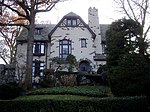Kew-Forest School
Educational institutions established in 1918Preparatory schools in New York CityPrivate K-12 schools in New York CityPrivate elementary schools in Queens, New YorkPrivate high schools in Queens, New York ... and 1 more
Private middle schools in Queens, New York

The Kew-Forest School is an independent, co-ed, college preparatory school for students in grades Pre-Kindergarten-Grade 12. The school was established in 1918 primarily for residents of Forest Hills and Kew Gardens, Queens, New York.
Excerpt from the Wikipedia article Kew-Forest School (License: CC BY-SA 3.0, Authors, Images).Kew-Forest School
Union Turnpike, New York Queens
Geographical coordinates (GPS) Address External links Nearby Places Show on map
Geographical coordinates (GPS)
| Latitude | Longitude |
|---|---|
| N 40.713611111111 ° | E -73.833333333333 ° |
Address
Kew-Forest School
Union Turnpike 119-17
11375 New York, Queens
New York, United States
Open on Google Maps










